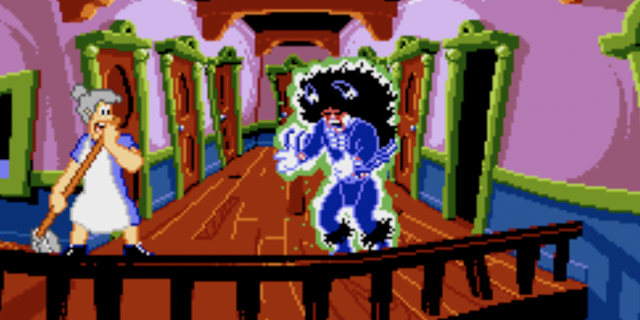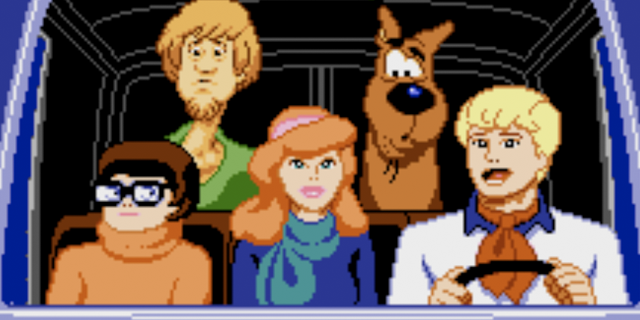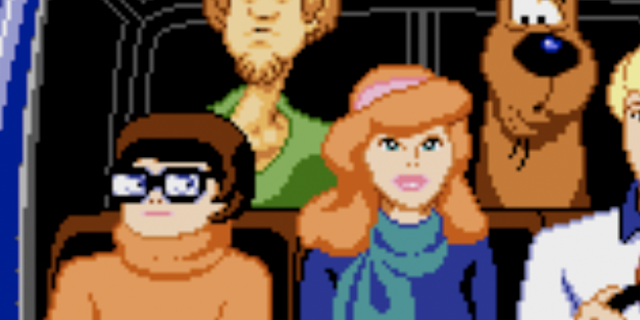I’ve pontificated in the past about my love for the licensed game, as well as my willingness to come to its defense in the perspective of game history. Plenty of great games have been based on existing properties, but get lost to the winds of time due to rights issues. They can also get bogged down by the sheer amount of games based on that property. Such is the case for Scooby-Doo Mystery on Sega Genesis. There have been tons of games based on the Scooby-Doo franchise, but I’d venture to say this may be the only good one. Things are even further confusing for this game as it’s not even the only one with that title.
On the Super NES, Scooby-Doo Mystery is a crappy platformer. But on Genesis, it’s a wonderful point-and-click adventure game. One of the easiest ways to make a licensed game is to completely rip off a popular game style and re-skin it with your new property. It worked for Darkwing Duck using the Mega Man 5 engine, and it works here. Scooby-Doo Mystery is basically a LucasArts SCUMM game, with Shaggy and the gang solving the mystery rather than Guybrush Threepwood or Sam and Max.
Everything about the LucasArts SCUMM titles is nailed down in this game, like the goofy humor, ridiculous logic-based puzzles and pretty backgrounds. Granted, they’re a lot less pretty on the Genesis than PC, but it works. Anyone who’s seen more than a few episodes of the classic Scooby-Doo cartoon (or any of the ton of sequel series) knows that the mystery-solvin’ is usually left to the smarter, preppier members of Mystery Inc., while Scoob ‘n Shag kind of loaf around and serve as comic relief. In Scooby-Doo Mystery for Sega Genesis, the tables have been turned. I don’t know what Daphne, Fred and Velma are doing this whole time, but I certainly did all the work, including clue-gathering, interrogating suspicious characters and setting a trap for them later.
The game controls just like a LucasArts SCUMM, but a lot more annoyingly. The cursor is moved by the d-pad and glides across the screen incredibly slowly and painfully. At times, USE-ing items in conjunction with other things can be confusing. If I’m handed a note that already gives me information about an object, I won’t think to use the note on said object because I already know what it says. Had the game just allowed me to take that knowledge and put it to use, the puzzle could flow better. Even the exaggerated character animations are emulated in this title. Everyone’s mouth moves like this guy:
It even keeps the frustratingly obtuse logic needed to progress in these games. For instance, I had to eat antacid in front of the cook so he’d assume I’m starving and run off to find me food. When the game gives you ten actions and each one of them requires dragging the slowest cursor ever across the screen and then into your inventory, your yearning to experiment depletes quickly.
The only major failing I can find for this game, outside the incredibly-slow cursor interface, is the fact that there’s no real mystery to solve. Shaggy sort of stumbles his way through the adventure, collecting items that aren’t really clues as much as just items to help the player move along to the next area. When I discovered who the culprit was in both scenarios, I thought “who?,” as we hadn’t even met the guy in the game. It’s still a weird little piece of game history that I think you should check out. An original cart can be found on eBay for about $25. That’s a bit pricey for a Genesis game, but I think it’s a good addition to any collec-wait a minute…
Do you think…
Oh my god!
She did it!
Shoot Matt an email if you have an idea for something you’d like him to cover. What do you think about Scooby-Doo Mystery? Does this game have a cat somewhere that we didn’t get a screenshot of? Let us know in the comments.

























